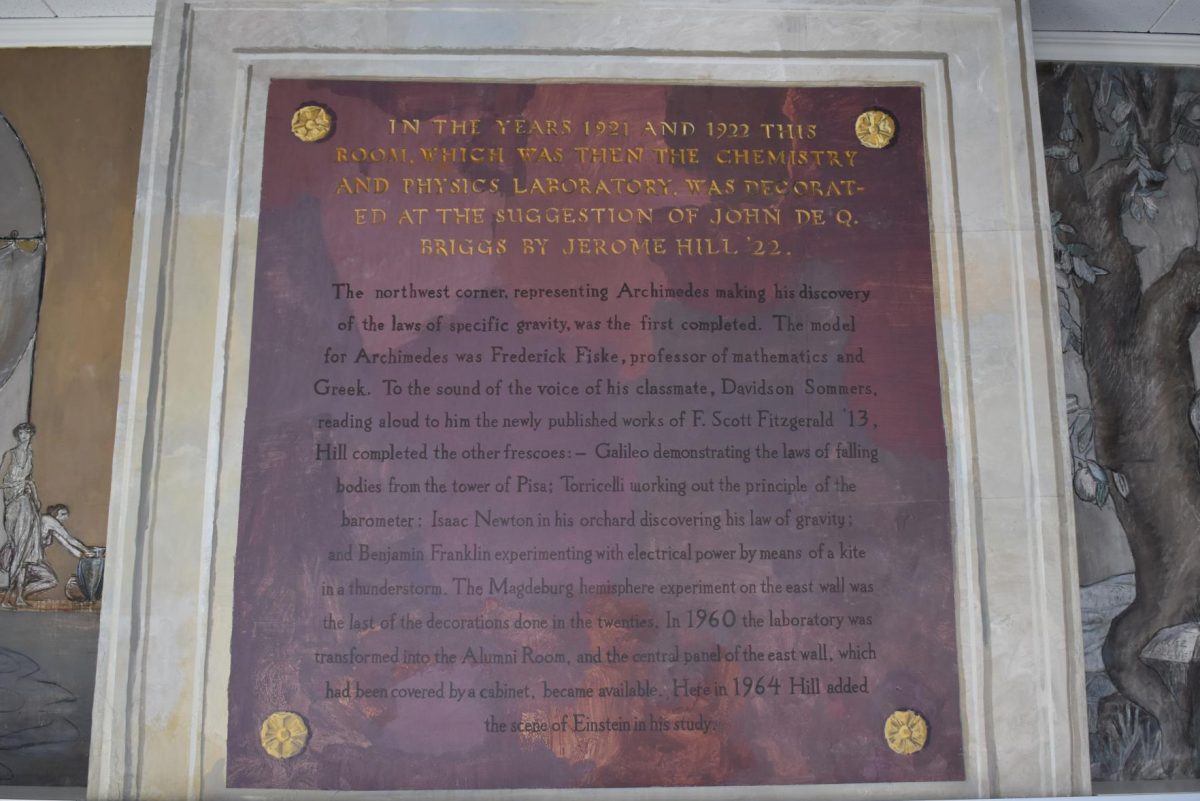White walls usually decorate the common classroom. However, cool toned murals of historically famous figures color the walls of room 5335. Now dubbed the “Mural Room,” it was originally used as a science lab when SPA was a boys military school. The murals were painted by Jerome Hill in 1922 of his senior year.
Hill was the grandson of James Jerome Hill, a prominent railroad builder in the upper midwest during the Gilded Age. Hill exhibited an early interest in the arts, resulting in his works in the mural room. He went on to become a successful artist working with a range of mediums from film to paint and traveling between the U.S. and Europe. One of his most notable achievements was winning an Academy Award for Best Documentary (Feature) in 1958 for his biographical documentary on the German-French polymath, Albert Schweitzer. Hill died from cancer in 1975. Much of his legacy is with the Jerome Hill Foundation offering grants to support early-career artists.
Another part of his legacy is vested in the history room on the third floor. On the walls of the mural room are scenes of historic mathematicians and scientists making their groundbreaking discoveries. Perpendicular to the window, you’ll find Italian physicist and mathematician Evangelista Toricelli inventing the barometer. Next to him is the scene of the polymath Galileo Galilei dropping objects from the top of the Leaning Tower of Pisa. To the right is Archimedes of Syracuse rushing out of his bath only wearing a towel after a revelation. Closest to the door, an apple falls on Isaac Newton’s face as he naps under a tree. Across from Newton is Benjamin Franklin flying a kite in a storming field. The gray skies in Franklin’s scene lead to a tranquil scene of physicist Albert Einstein at his desk with his pet dog facing a window. Above Einstein is his famous equation for mass-energy equivalence: E=mc2. Outside of Einstein’s window is a painting depicting the Magdeburg hemispheres experiment.

According to a plaque further describing the murals and the process, Hill painted while his classmate, David Sommers read “aloud to him the newly published works of F. Scott Fitzgerald (1913),” another prominent graduate of SPA.
Bill Levin (1968) first encountered the mural room in 1962 when he arrived at SPA in seventh grade. “My classmates and I were quite taken with it,” Levin said. “It was a beautiful, quiet space. And with a rather compact school and a lot of students, there were not very many quiet places.”
In the 60s, the room was called the “Alumni Room” and was used primarily for alumni and faculty meetings. Student functions were not allowed there. Yet, “We peeked in there [because] we were quite attracted to the mural and the subject of the mural,” He said. Levin’s favorite painting is Archimedes’ “Eureka” moment which he described as “a cheerful thing to see.”
History teacher Scott Telfer was also fascinated by Archimedes. Telfer is a long-term substitute teacher for history teachers, for example, when they go on sabbatical. Sometimes feeling awkward occupying other teachers’ offices, Telfer used the mural room as a temporary unofficial office.
“As a history teacher, I love looking at drawings that were done by students in the 1920s. I thought that was fascinating,” Telfer said. “And it was amazing how many teachers never visited there.” So, he invited other teachers to come up to the room when he had the chance.
Other than the murals, Hill also seemed to be an intriguing figure: “Clearly, Jerome must have caught the imagination of [headmaster] John de Q. Briggs…because, otherwise, why would that person allow Jerome the time and materials and whatever to [paint the room],” Levin said.
SPA did not have a fine arts program until 1965. “I guess in hindsight, it kind of offered the idea that the potential [for a fine arts program] was there, even though there hadn’t been any instruction,” Levin said.
Nearing the end of his middle school career, Levin remembers seeing scaffolds and tarps filling the room. Hill returned to touch-up the paintings. After a second renovation, cabinets were torn down from the room. Hill filled that space with the painting of Einstein in 1964.
Part of Sara Johnson’s job as Director of Institutional Advancement is working with alumni. Black and white photos of SPA students and faculty from the 20th century hang in her office. As someone who has a clearer understanding of the school’s history, Johnson feels a special connection to the school and its history in the room.
“As students and teachers who are here now and forming our community now, your experience is the experience of the present day,” she said. “But there is something really special to know that, 100 years ago, there were students just like you…and they were painting these murals in that room the same way, today, students might be in the art wing.”